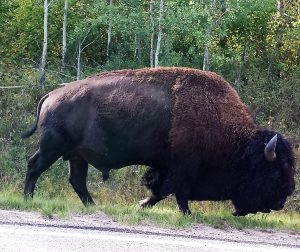Pemmican Empire
A recent article about Chef Shane Chartrand poses the question “How can one claim to be Canadian and never tasted pemmican?”[i] . Pemmican is included in Feast: Recipes and stories from a Canadian road trip (Anderson & VanVeller, 2017). The television show and blog “Wild Kitchen” gives recipes and instructions for what has been called “Canada’s first energy bar”.
Pemmican Empire (2015) by George Colpitts of the University of Calgary recognizes the economic, social, environmental and political consequences of the pemmican trade to Canada.
It all began with bison, which, as Canadian school children may know, swept across the prairies in massive herds and sustained First Nations peoples over millennia. Bison were important in cultural and spiritual traditions as well as a critical food source. One way to preserve the bounty of meat was to give it away to others who needed it. Colpitts proposes that this generosity, also called “commensality” was a form of reciprocity to safeguard future food supplies, especially during the summer when fresh meat would spoil quickly.
Pemmican production developed as a way to achieve year-round food security. Plains archeologists have determined that pemmican production began 5,000 to 6,000 years ago. After the winter bison hunts, excess meat was dried, pounded into fine powder, mixed with fat and packed into air-tight skin bags. It would keep almost indefinitely[ii]. With 3,200 to 3,500 calories per pound of pemmican, it was an extremely efficient, compact and nutritious preservation method. Berries could be added to increase palatability and extra nutrients.
The arrival of newcomers, mostly white European males, on the North American continent presaged the end of the bison. Colpitts describes the last 100 years of North American bison hunts (1780 – 1882) in themes that resonate with Garrett Hardin’s 1968 article The Tragedy of the Commons[iii]. The shared-resource system of the First Nations across the prairies became a commercial enterprise, as fur-trading companies demanded more and faster routes to market. The legendary voyageurs paddled and portaged up to 13 hours daily; they could not survive on grain-fed diets. Pemmican became the means to sustain the fur trade, and initially had extensive economic benefits. Colpitts details the effects of wastage, over-kill and economic exploitation, particularly on First Nations peoples. I cannot help but think about the similarities to cod overfishing on the East Coast, or the current use of non-renewable natural resources such as oil and gas.
Pemmican might be the ultimate Canadian identity food. Is it also the ultimate Canadian tragedy?
References:
Anderson, L. & VanVeller, D. (2017). Feast: Recipes and stories from a Canadian road trip. Random House.
Colpitts, G. (2015)/ Pemmican Empire: Food, trade and the last bison hunts in the North American plains, 1780 – 1882. Cambridge, UK: Cambridge University Press.
Hardin, G. (1968). Tragedy of the commons. Science, 162 (3859), 1243-1248. https://science.sciencemag.org/content/162/3859/1243
Lugonja, V. (2017). Homemade pemmican: Cooking in the kitchen with Chef Shane Chartrand of Marrow, Progressive Indigenous Cuisine. https://www.acanadianfoodie.com/2017/04/11/homemade-pemmican/
Endnotes:
[i] Lugonja, V. (2017). https://www.acanadianfoodie.com/2017/04/11/homemade-pemmican/
[ii] In the 1950s, bags of pemmican were allegedly found cached in trees in Sturgeon County, north of Edmonton.
[iii] “The tragedy of the commons is an economic theory of a situation within a shared-resource system where individual users acting independently and rationally according to their own self-interest behave contrary to the common good of all users by depleting that resource”. https://en.wikipedia.org/wiki/Tragedy_of_the_commons

